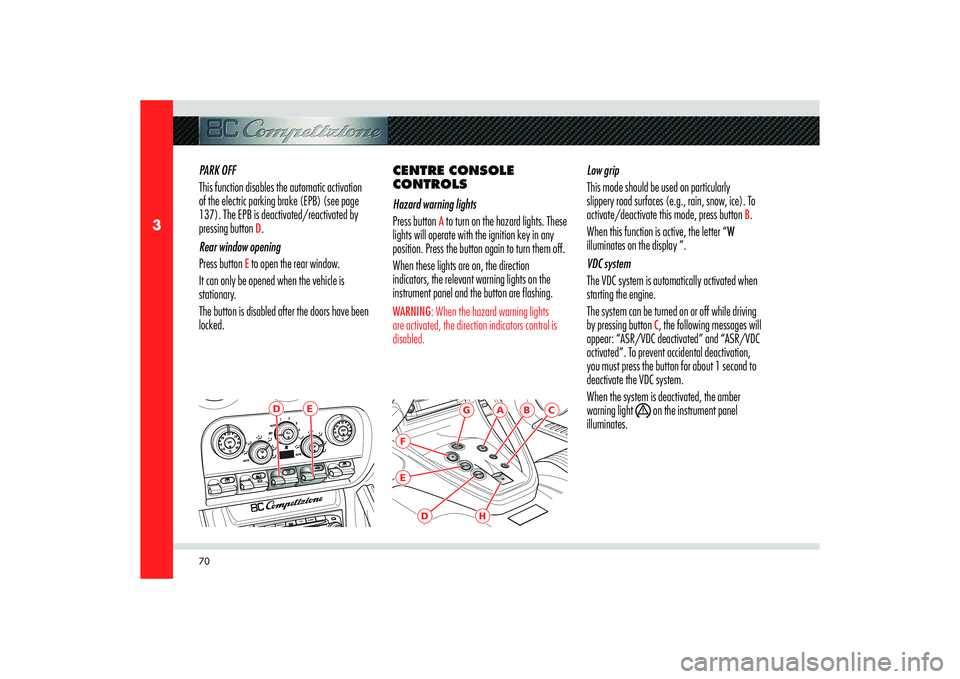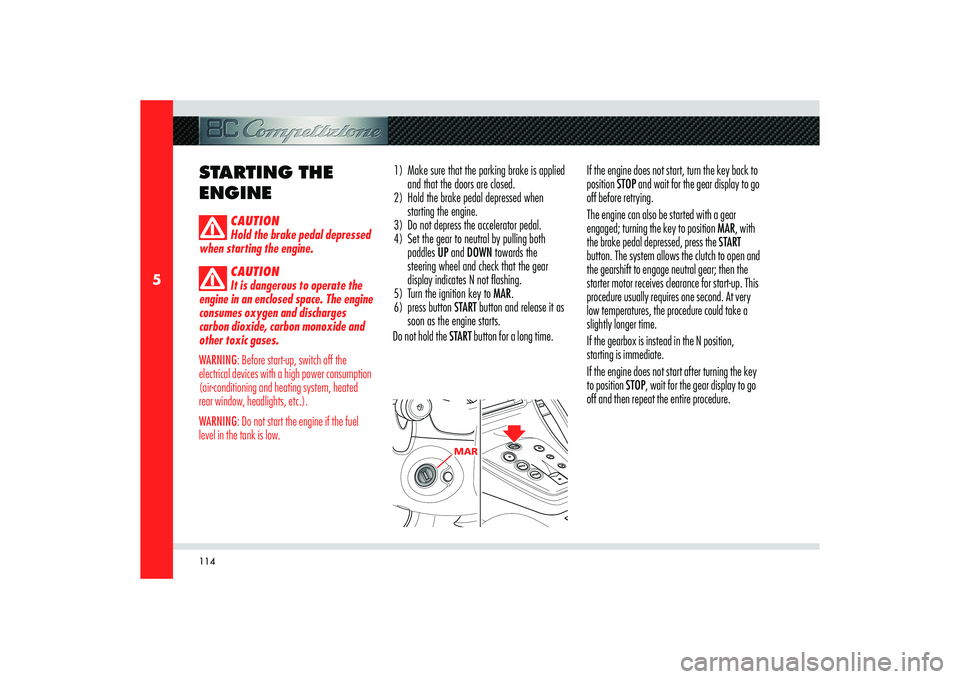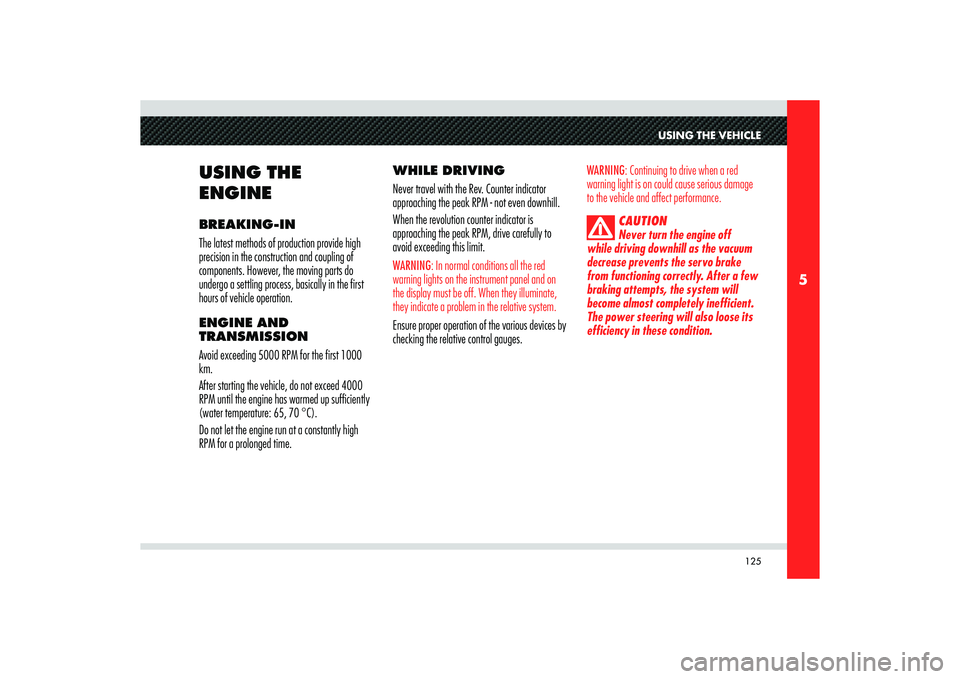brake light Alfa Romeo 8C 2009 Owner handbook (in English)
[x] Cancel search | Manufacturer: ALFA ROMEO, Model Year: 2009, Model line: 8C, Model: Alfa Romeo 8C 2009Pages: 223, PDF Size: 14.35 MB
Page 72 of 223

70
3
E
D
B
A
G
FE
D
H
C
PARK OFF
This function disables the automatic activation
of the electric parking brake (EPB) (see page
137). The EPB is deactivated/reactivated by
pressing button
D.
Rear window opening
Press button
E to open the rear window.
It can only be opened when the vehicle is
stationary.
The button is disabled after the doors have been
locked.CENTRE CONSOLE
CONTROLS
Hazard warning lights
Press button
A to turn on the hazard lights. These
lights will operate with the ignition key in any
position. Press the button again to turn them off.
When these lights are on, the direction
indicators, the relevant warning lights on the
instrument panel and the button are flashing.
WARNING: When the hazard warning lights
are activated, the direction indicators control is
disabled.
Low grip
This mode should be used on particularly
slippery road surfaces (e.g., rain, snow, ice). To
activate/deactivate this mode, press button
B.
When this function is active, the letter “W
illuminates on the display ”.
VDC system
The VDC system is automatically activated when
starting the engine.
The system can be turned on or off while driving
by pressing button
C, the following messages will
appear: “ASR/VDC deactivated” and “ASR/VDC
activated”. To prevent accidental deactivation,
you must press the button for about 1 second to
deactivate the VDC system.
When the system is deactivated, the amber
warning light
on the instrument panel
illuminates.
Page 86 of 223

84
4
B
OPERATION
Each time the ignition key is removed from
position STOP the protection system activates
the engine immobilizer.
Upon starting the engine, when the key is turned
to MAR:
1) If the code is recognised, the CODE
warning light on the instrument panel turns
off in one second, while the EOBD
warning light turns off after about four
seconds, after the ECU has completed its
diagnostic cycle. The protection system has
recognised the key code and deactivates the
engine immobilizer. With the brake pedal
depressed, pushing the START button, the
engine starts.
2) If the CODE warning light remains on
and the EOBD warning light goes off
after four seconds (ECU diagnostics) and
illuminates again immediately afterwards,
the code has not been recognised and the
message “Electronic key not recognised”
is displayed. In this case, it is advisable to
turn the key back to position STOP and
then back to MAR; If the immobilizer stays
on, try with the other keys. If you are still FUEL TANK DOOR
EMERGENCY OPENING
If necessary, the fuel tank door can be opened
by pulling the cable
B housed in the luggage
compartment, in the beauty case compartment
KEYSTHE ALFA ROMEO CODE
SYSTEM
In order to enhance protection against thefts,
the vehicle is equipped with an electronic engine
immobilizer system (Alfa Romeo CODE), which
is automatically activated when the ignition key
is removed.
Each starter key contains an electronic device
which transmits a code signal to the Alfa Romeo
CODE control unit, and engine ignition is enabled
only if the key code is recognised by the system.
Two keys are provided with the vehicle.
The key is used to:
- start the engine
- activate the central door locking system
- deactivate/activate the passenger airbag
(on vehicles equipped with manual
deactivation system)
- open the rear window
- activate/deactivate the alarm system
Page 115 of 223

5
USING THE VEHICLE
Starting the engine ............................................................................................................ 114
Q-Select gearbox ............................................................................................................... 116
Using the brakes ................................................................................................................ 124
Using the engine ............................................................................................................... 125
Constant speed regulator (Cruise Control) .............................................................................. 126
Headlights ........................................................................................................................ 130
Driving conditions .............................................................................................................. 130
Anti-pollution devices ......................................................................................................... 135
Parking ............................................................................................................................ 136
Tyres ................................................................................................................................ 141
Useful accessories to keep in the vehicle ............................................................................... 142
Page 116 of 223

114
5
MAR
STARTING THE
ENGINE
CAUTION
Hold the brake pedal depressed
when starting the engine.
CAUTION
It is dangerous to operate the
engine in an enclosed space. The engine
consumes oxygen and discharges
carbon dioxide, carbon monoxide and
other toxic gases.
WARNING: Before start-up, switch off the
electrical devices with a high power consumption
(air-conditioning and heating system, heated
rear window, headlights, etc.).
WARNING: Do not start the engine if the fuel
level in the tank is low.
1) Make sure that the parking brake is applied
and that the doors are closed.
2) Hold the brake pedal depressed when
starting the engine.
3) Do not depress the accelerator pedal.
4) Set the gear to neutral by pulling both
paddles UP and DOWN towards the
steering wheel and check that the gear
display indicates N not fl ashing.
5) Turn the ignition key to MAR.
6) press button START button and release it as
soon as the engine starts.
Do not hold the START button for a long time.If the engine does not start, turn the key back to
position STOP and wait for the gear display to go
off before retrying.
The engine can also be started with a gear
engaged; turning the key to position MAR, with
the brake pedal depressed, press the START
button. The system allows the clutch to open and
the gearshift to engage neutral gear; then the
starter motor receives clearance for start-up. This
procedure usually requires one second. At very
low temperatures, the procedure could take a
slightly longer time.
If the gearbox is instead in the N position,
starting is immediate.
If the engine does not start after turning the key
to position STOP, wait for the gear display to go
off and then repeat the entire procedure.
Page 120 of 223

118
5
If the symbol
remains on, there is a system
failure. This condition is also indicated by a beep
when the key is turned to position MAR.
WARNING: Contact an Authorised Service
Centre of the Manufacturer’s Network to have
the malfunction corrected.
OPERATION WITH THE
ENGINE OFF
After completing the “system start-up” stage,
the gear currently engaged will appear on the
display:
- N (Neutral)
- R (Reverse)
- D(1
st).
If the indication flashes (may also occur with N)
it means that the gear is not properly engaged or
is disengaged; therefore, request neutral (N) and
then the desired gear.CAUTION
If a horizontal dash appears on
the display, there is a system failure.
When the engine is off, 1st gear, reverse (R) and
neutral (N) can be engaged. Keeping the brake
pedal pressed during the request, you must
proceed as follows:
- N (Neutral): pull both paddles found behind
the steering wheel.
- R (Reverse): press button
C.
- Engaging 1
st gear: pull the UP paddle
towards the steering wheel.
CAUTION
To engage reverse gear, hold
the button C down until the letter R is
displayed.
WARNING: Immediately release the paddles
UP, DOWN and the button R after the gearshift
request. A prolonged manoeuvre may cause
the failure warning light
and the buzzer
to activate. Do not operate the system with the
engine off, to prevent discharging the battery.
Avoid useless gearshifting with the engine off, to
prevent overheating of the pump.
Page 126 of 223

124
5
WARNING: In the event that the control lever
assembly is malfunctioning, in addition to
activating the buzzer and the failure warning
light
, the system enables “automatic
gearshift” mode and any gearshift command,
including the request for N and R, will be
ignored.
WARNING: If the malfunction persists,
contact an Authorised Service Centre of the
Manufacturer’s Network as soon as possible to
have the malfunction corrected.
PUSH START
In the case of malfunctioning of the starter
system, you can push-start the vehicle
proceeding as follows
- perform the “system start-up” stage
- request UP while the vehicle is picking up
speed with the gearbox in N.WARNING: This procedure should not be used
unless there is an emergency situation!
USING THE
BRAKESTo allow the brake pads and discs to run in
properly, avoid sudden braking during the first
300 km.
The ABS is a component of the braking system
that provides two basic advantages:
- It avoids locking of the wheels and thus
skidding during emergency braking,
especially under low grip conditions.
- It makes it possible to brake and steer at
the same time in order to avoid unexpected
obstacles or to direct the vehicle where
desired when braking: this is in keeping
with the physical limits of the tyre side grip. In order to fully exploit the ABS:
- You will note a light vibration of the brake
pedal during emergency braking or braking
under low grip conditions: This indicates
that the ABS is operating. Do not release
the pedal but continue to press it to give
continuity to the braking action.
- The ABS prevents the wheels from locking,
but it does not increase the physical grip
limits between the tyres and the road.
So, even with vehicles equipped with
ABS, always ensure that you keep to a
safe distance from the vehicle in front and
reduce your speed when entering a bend.
Page 127 of 223

125
5
USING THE VEHICLE
USING THE
ENGINEBREAKING-IN
The latest methods of production provide high
precision in the construction and coupling of
components. However, the moving parts do
undergo a settling process, basically in the first
hours of vehicle operation.
ENGINE AND
TRANSMISSION
Avoid exceeding 5000 RPM for the first 1000
km.
After starting the vehicle, do not exceed 4000
RPM until the engine has warmed up sufficiently
(water temperature: 65, 70 °C).
Do not let the engine run at a constantly high
RPM for a prolonged time.WHILE DRIVING
Never travel with the Rev. Counter indicator
approaching the peak RPM - not even downhill.
When the revolution counter indicator is
approaching the peak RPM, drive carefully to
avoid exceeding this limit.
WARNING: In normal conditions all the red
warning lights on the instrument panel and on
the display must be off. When they illuminate,
they indicate a problem in the relative system.Ensure proper operation of the various devices by
checking the relative control gauges.
WARNING: Continuing to drive when a red
warning light is on could cause serious damage
to the vehicle and affect performance.
CAUTION
Never turn the engine off
while driving downhill as the vacuum
decrease prevents the servo brake
from functioning correctly. After a few
braking attempts, the system will
become almost completely inefficient.
The power steering will also loose its
efficiency in these condition.
Page 128 of 223

126
5
Engine control system (EOBD)
The EOBD (European On Board Diagnosis)
system fitted on the vehicle is compliant with the
2003/76B/EC Directive (EURO 4).
This system continuously monitors the
components of the vehicle related to emissions;
it also indicates, when the warning light
illuminates on the instrument panel, that the
components in question are in poor condition.
The objective is the following:
- monitor the system effi ciency
- indicate when a problem causes an
increase in emissions exceeding the limits
established by European regulations
- indicate the need for replacement of worn
components.In addition, the system includes a diagnostics
connector that can be interfaced with suitable
instruments. This makes it possible to read the
error codes stored in the control unit, together
with a set of specific parameters for engine
operation diagnostics.
WARNING: If when turning the ignition key
to MARthe warning light
does not
illuminate or if it illuminates while driving,
contact an Authorised Service Centre of the
Manufacturer’s Network as soon as possible.
WARNING: After correcting the malfunction, the
entire system must be tested by the personnel
of an Authorised Service Centre of the
Manufacturer’s Network that must perform
tests on the bench and, if necessary, the road
test the vehicle: this might require travelling long
distances.
CONSTANT SPEED
REGULATOR (CRUISE CONTROL)GENERAL
The Cruise Control function allows the driver
to maintain the desired vehicle speed constant
without pressing the accelerator pedal. This
reduces driver fatigue on highways, especially
long trips, as the set speed is automatically
maintained.WARNING: The device can only be activated at
speeds exceeding 30 km/h and it deactivates
automatically when the brake pedal is
depressed.
Page 130 of 223

128
5
RESTORING THE SPEED
STORED IN THE MEMORY
If the device has been deactivated after braking,
the speed saved previously can be restored as
follows:
- gradually accelerate until you reach a speed
close to that stored;
- engage the gear selected when the speed
was stored (4
th, 5th or 6
th gear);
- press button
C (RCL).INCREASING THE SPEED
STORED IN THE MEMORY
The speed stored in the memory can be
increased in two ways:
- Depressing the accelerator pedal and then
storing the new speed reached (holding the
dial
B turned for more than three seconds)
or
- momentarily turning the dial
B to (+): each
impulse transmitted by the dial will cause
a slight increase in speed (about 1 Km/h),
whereas a constant pressure on the same
dial will cause a continuous increase in
speed. When the dial
B is released, the new
speed will automatically be stored.REDUCING THE SPEED
STORED IN THE MEMORY
The speed stored in the memory can be reduced
in two ways:
- Deactivating the device by depressing the
brake pedal and then storing the new speed
(turning the dial
B to (+) for at least three
seconds).
or
- Holding the dial turned
B to (–) until
reaching the new speed, which will
automatically be stored.
Page 134 of 223

132
5
TRAVELLING
- Caution is the fi rst rule for safe driving.
Being careful also means being in a position
to be able to predict the driving behaviour
of other drivers, that may be wrong or
careless.
- Keep a safe distance from vehicles in front
of you, adjusting this distance in accordance
to the vehicle speed and traffi c conditions.
- Strictly follow the traffi c regulations
applicable in each country and above all,
respect the speed limits.
- Long trips should be started in optimal
physical condition.
CAUTION
Drunk driving, or driving
under the influence of drugs or certain
medicines is extremely dangerous for
the driver and for others.CAUTION
Always fasten the seat belts.
Travelling without your seat belt
fastened increases the risk of serious
injury in the event of a collision.
- Make regular stops to loosen up your limbs
and refresh yourself, and avoid driving for
hours on end.
- Ensure that the air inside the passenger
compartment is changed constantly.
- Never coast downhill with the engine off:
the braking action requires greater effort on
the pedal due to the absence of the engine
brake and the power braking system. DRIVING AT NIGHT
The main guidelines to follow when driving at
night are set out below:
- Drive with the greatest caution: at night the
driving conditions are more demanding.
- Reduce your speed, especially on roads with
no street lights.
- At the fi rst signs of drowsiness, stop: to
continue driving would be a risk for yourself
and for others. Continue only after you have
had a rest.
- Keep the vehicle at a greater distance from
vehicles in front of you than you would
during the day: it is diffi cult to assess the
speed of other vehicles when you can only
see the lights.
- Make sure that the headlights are aimed
correctly: if they are too low, they reduce
visibility and strain the eyes. If they are too
high, they may bother the drivers of other
cars.